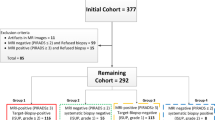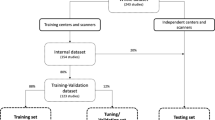Abstract
Background
Urethral injuries (UIs) are significant complications pertaining to transanal total mesorectal excision (TaTME). It is important for surgeons to identify the prostate during TaTME to prevent UI occurrence; intraoperative image navigation could be considered useful in this regard. This study aims at developing a deep learning model for real-time automatic prostate segmentation based on intraoperative video during TaTME. The proposed model’s performance has been evaluated.
Methods
This was a single-institution retrospective feasibility study. Semantic segmentation of the prostate area was performed using a convolutional neural network (CNN)-based approach. DeepLab v3 plus was utilized as the CNN model for the semantic segmentation task. The Dice coefficient (DC), which is calculated based on the overlapping area between the ground truth and predicted area, was utilized as an evaluation metric for the proposed model.
Results
Five hundred prostate images were randomly extracted from 17 TaTME videos, and the prostate area was manually annotated on each image. Fivefold cross-validation tests were performed, and as observed, the average DC value equaled 0.71 ± 0.04, the maximum value being 0.77. Additionally, the model operated at 11 fps, which provides acceptable real-time performance.
Conclusions
To the best of the authors’ knowledge, this is the first effort toward realization of computer-assisted TaTME, and results obtained in this study suggest that the proposed deep learning model can be utilized for real-time automatic prostate segmentation. In future endeavors, the accuracy and performance of the proposed model will be improved to enable its use in practical applications, and its capability to reduce UI risks during TaTME will be verified.



Similar content being viewed by others
References
Sylla P, Rattner DW, Delgado S, Lacy AM (2010) NOTES transanal rectal cancer resection using transanal endoscopic microsurgery and laparoscopic assistance. Surg Endosc 24:1205–1210
Buchs NC, Penna M, Bloemendaal AL, Hompes R (2016) Transanal total mesorectal excision: myths and reality. World J Clin Oncol 7:337–339
Monson JRT, Arsalanizadeh R (2016) Transanal total mesorectal excision (TaTME) and quality of rectal cancer surgery: do we really know? Ann Surg 266:e88–e89
Deijen CL, Tsai A, Koedam TWA et al (2016) Clinical outcomes and case volume effect of transanal total mesorectal excision for rectal cancer: a systematic review. Tech Coloproctol 20:811–824
Penna M, Hompes R, Arnold S et al (2016) Transanal total mesorectal excision: International registry results of the first 720 cases. Ann Surg 266:111–117
Burke J, Martin-Perez B, Khan A et al (2016) Transanal total mesorectal excision for rectal cancer: early outcomes in 50 consecutive patients. Colorectal Dis 18:570–577
Rouanet P, Mourregot A, Azar C et al (2013) Transanal endoscopic proctectomy: an innovative procedure for difficult resection of rectal tumors in men with narrow pelvis. Dis Colon Rectum 56:408–415
Kang L, Chen W, Luo S et al (2016) Transanal total mesorectal excision for rectal cancer: a preliminary report. Surg Endosc 30:2552–2562
Schirnhofer J, Brunner E, Mittermair C et al (2014) Technical issues in transanal minimal invasive surgery: total mesorectal excisions (TAMIS-TME). Eur Surg 46:S58
Perdawood S, Thinggaard B, Bjoern M (2018) Effect of transanal total mesorectal excision for rectal cancer: comparison of short-term outcomes with laparoscopic and open surgeries. Surg Endosc 32:2312–2321
Shelhamer E, Long J, Darrell T (2017) Fully convolutional networks for semantic segmentation. IEEE Trans Pattern Anal Mach Intell 39(4):640–651
Ghavami N, Hu Y, Gibson E et al (2019) Automatic segmentation of prostate MRI using convolutional neural networks: investigating the impact of network architecture on the accuracy of volume measurement and MRI-ultrasound registration. Med Image Anal 58:101558
Karimi D, Samei G, Kesch C et al (2018) Prostate segmentation in MRI using a convolutional neural network architecture and training strategy based on statistical shape models. Int J Comput Assist Radiol Surg 13(8):1211–1219
Ma L, Guo R, Zhang G et al (2017) Automatic segmentation of the prostate on CT images using deep learning and multi-atlas fusion. Proc SPIE Int Soc Opt Eng 10133:101332O
Liu C, Gardner SJ, Wen N et al (2019) Automatic segmentation of the prostate on CT images using deep neural networks (DNN). Int J Radiat Oncol Biol Phys 104(4):924–932
Wijsmuller AR, Romagnolo LGC, Agnus V et al (2018) Advances in stereotactic navigation for pelvic surgery. Surg Endosc 32(6):2713–2720
Kwak JM, Romagnolo L, Wijsmuller A et al (2019) Stereotactic pelvic navigation with augmented reality for transanal total mesorectal excision. Dis Colon Rectum 62(1):123–129
Chen LC, Zhu Y, Papandreou G et al (2018) Encoder-decoder with atrous separable convolution for semantic image segmentation. arXiv:1802.02611v3 [cs.CV] 22 Aug 2018.
Russakovsky O, Deng J, Su H et al (2015) Imagenet large scale visual recognition challenge. Int J Comput Vis 115:211–252
Atallah S, Albert M, Monson JR (2016) Critical concepts and important anatomic landmarks encountered during transanal total mesorectal excision (taTME): toward the mastery of a new operation for rectal cancer surgery. Tech Coloproctol 20:483–494. https://doi.org/10.1007/s10151-016-1475-x
Knol J, Chadi SA (2016) Transanal total mesorectal excision: technical aspects of approaching the mesorectal plane from below. Minim Invasive Ther Allied Technol 25:257–270. https://doi.org/10.1080/13645706.2016.1206572
Atallah S, Mabardy A, Volpato AP et al (2017) Surgery beyond the visible light spectrum: theoretical and applied methods for localization of the male urethra during transanal total mesorectal excision. Tech Coloproctol 21:413–424
Atallah S, Martin-Perez B, Drake J et al (2015) The use of a lighted stent as a method for identifying the urethra in male patients undergoing transanal total mesorectal excision: a video demonstration. Tech Coloproctol 19:375. https://doi.org/10.1007/s10151-015-1297-2
Barnes TG, Penna M, Hompes R, Cunningham C (2017) Fluorescence to highlight the urethra: a human cadaveric study. Tech Coloproctol 21:439–444. https://doi.org/10.1007/s10151-017-1615-y
Nitta T, Tanaka K, Kataoka J et al (2019) Novel technique with the IRIS U kit to prevent urethral injury in patients undergoing transanal total mesorectal excision. Ann Med Surg 46:1–3
Koedam TWA, Veltcamp Helbach M, van de Ven PM et al (2018) Transanal total mesorectal excision for rectal cancer: evaluation of the learning curve. Tech Coloproctol 22:279–287. https://doi.org/10.1007/s10151-018-1771-8
Lee L, Kelly J, Nassif GJ et al (2020) Defining the learning curve for transanal total mesorectal excision for rectal adenocarcinoma. Surg Endosc 34:1534–1542. https://doi.org/10.1007/s00464-018-6360-4
Veltcamp Helbach M, van Oostendorp SE, Koedam TWA et al (2020) Structured training pathway and proctoring; multicenter results of the implementation of transanal total mesorectal excision (TaTME) in the Netherlands. Surg Endosc 34:192–201. https://doi.org/10.1007/s00464-019-06750-w
van Oostendorp SE, Belgers HJ, Bootsma BT et al (2020) Locoregional recurrences after transanal total mesorectal excision of rectal cancer during implementation. Br J Surg. https://doi.org/10.1002/bjs.11525
Allan M, Shvets A, Kurmann T et al (2019) 2017 robotic instrument segmentation challenge. arXiv:1902.06426v2 [cs.CV] 21 Feb 2019
Wang Y, Zhou Y, Shen W et al (2019) Abdominal multi-organ segmentation with organ-attention networks and statistical fusion. Med Image Anal 55:88–102
Acknowledgements
This work was supported by JSPS KAKENHI Grant Number JP18K16378.
Funding
This work was supported by Japan Society for the Promotion of Science (JSPS KAKENHI) Grant Number JP18K16378.
Author information
Authors and Affiliations
Corresponding authors
Ethics declarations
Disclosure
Daichi Kitaguchi, Nobuyoshi Takeshita, Hiroki Matsuzaki, Hiro Hasegawa, Ryoya Honda MD, Koichi Teramura, Tatsuya Oda, and Masaaki Ito have no conflicts of interest or financial ties to disclose.
Additional information
Publisher's Note
Springer Nature remains neutral with regard to jurisdictional claims in published maps and institutional affiliations.
Rights and permissions
About this article
Cite this article
Kitaguchi, D., Takeshita, N., Matsuzaki, H. et al. Computer-assisted real-time automatic prostate segmentation during TaTME: a single-center feasibility study. Surg Endosc 35, 2493–2499 (2021). https://doi.org/10.1007/s00464-020-07659-5
Received:
Accepted:
Published:
Issue Date:
DOI: https://doi.org/10.1007/s00464-020-07659-5




